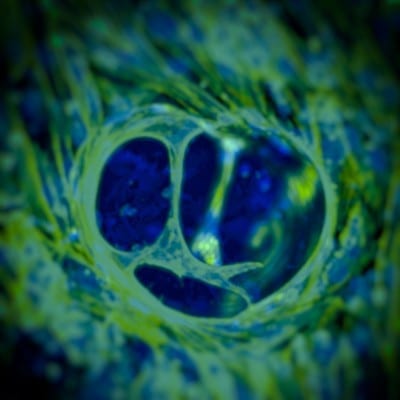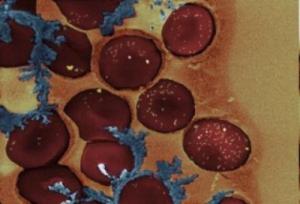Freiburg researchers develop hydrogels for tissue regeneration that can be fine-tuned to fit any body part
A new kind of gel that promotes the proper organization of human cells was developed by Prof. Prasad Shastri of the Institute of Macromolecular Chemistry and BIOSS Centre for Biological Signalling Studies Excellence Cluster at the University of Freiburg and BIOSS Centre for Biological Signalling Studies graduate students Aurelien Forget and Jon Christensen in collaboration with Dr. Steffen Lüdeke of the Institute for Pharmaceutical Sciences.
These hydrogels made of agarose, a polymer of sugar molecules derived from sea algae, mimic many aspects of the environment of cells in the human body. They can serve as a scaffold for cells to organize in tissues. In the cover article of the Proceedings of the National Academy of Sciences Prof. Shastri and co-workers show how by applying these hydrogels they could grow blood vessel structures from cells in an unparalleled way. These gels could be used in the future to help damaged tissue heal faster.
The cells environment in the body is composed of collagen and polymers of sugars. It provides mechanical signals to the cells, necessary for their survival and proper organization into a tissue, and hence essential for healing. A gel can mimic this scaffold. However it has to precisely reproduce the molecular matrix outside the cell in its physical properties. Those properties, like the matrices stiffness, vary in the body depending on the tissue.
The team of Prof. Shastri modified agarose gels by adding a carboxylic acid residue to the molecular structure of the polymer to optimally fit the cells environment. Hydrogels form when polymer chains that can dissolve in water are crosslinked. In an agarose gel the sugar chains organize into a spring-like structure. By adding a carboxylic acid to this backbone, the polymers form ribbon-like structures – this allows for the stiffness of the gel to be tuned to adapt the scaffold to every part of the human body.
To demonstrate the versatility of the gel the researchers manipulated endothelial cells that make up vascular tissue to organize into blood vessels outside the body. By combining the appropriate biological molecules found in a developing embryo, they identified a single condition that encourages endothelial cells to form large blood vessel-like structures, several hundred micrometers in height. This discovery has implications in treating damage to heart and muscle tissue.
The Latest Bing News on:
Tissue regeneration
- Japanese researchers test cardiac spheroids for heart regeneration in monkeyson April 26, 2024 at 9:33 pm
Regenerative heart therapies involve transplanting cardiac muscle cells into damaged areas of the heart to recover lost function.
- In a first, mice brain circuits regenerated using rat stem cellson April 25, 2024 at 8:29 am
Two independent research teams have achieved successful regeneration of mouse brain circuits by cultivating neurons from rat stem cells.
- The murky, unregulated world of anti-ageing stem cell therapyon April 24, 2024 at 10:50 am
Stem cells are the new focal point of the rich and famous with Hollywood A-listers reportedly spending tens of thousands of pounds each year on expensive therapies offered by private longevity clinics ...
- Tissue Engineering and Regeneration Market [2028]: Navigating Opportunities and Challengeson April 24, 2024 at 3:11 am
USD 14.57 billion in 2022 and is poised for substantial growth, projecting a Compound Annual Growth Rate (CAGR) of 8.35% through 2028.
- New small molecule helps scientists study regenerationon April 23, 2024 at 9:23 am
Regenerating damaged tissues or organs has been a dream of scientists for decades. Now, researchers at the FMI and Novartis Biomedical Research have discovered a new molecule that activates a protein ...
- Secrets of zebrafish heart regeneration could transform human cardiac careon April 20, 2024 at 12:30 pm
Zebrafish heart tissue regeneration is a captivating prospect for transformative advances in human cardiac care ...
- Why can zebrafish regenerate damaged heart tissue, while other fish species cannot?on April 20, 2024 at 12:07 pm
A heart attack will leave a permanent scar on a human heart, yet other animals, including zebrafish, can clear cardiac scar tissue and regrow damaged muscle as adults. Biologists sheds new light on ...
- Why zebrafish can regenerate damaged heart tissue, while other fish species cannoton April 19, 2024 at 8:16 am
A heart attack will leave a permanent scar on a human heart, yet other animals, including some fish and amphibians, can clear cardiac scar tissue and regrow damaged muscle as adults.
- $33 Million to Truly Regenerate Arthritic Jointson April 19, 2024 at 8:12 am
Duke School of Medicine, Boston Children’s Hospital, and University of California Los Angeles (UCLA) have been awarded a contract of up to $33 million from the Advanced Research Projects Agency for ...
- Cherokee Nation hosts ARPA-H’s novel osteoarthritis regeneration programon April 18, 2024 at 10:30 am
The Cherokee Nation recently hosted a successful kick-off event for the Advanced Research Projects Agency for Health's Novel Innovations for Tissue Regeneration in Osteoarthritis (NITRO) program. The ...
The Latest Google Headlines on:
Tissue regeneration
[google_news title=”” keyword=”tissue regeneration” num_posts=”10″ blurb_length=”0″ show_thumb=”left”]
The Latest Bing News on:
Healing tissue
- Kintsugi Space: the healing new wellness destination using quantum physics in Abu Dhabion April 27, 2024 at 11:00 pm
Kintsugi Space: the healing new wellness destination using quantum physics in Abu Dhabi - A new all-women’s club in the UAE taps into good vibrations to reveal a new you. Angelina Villa-Clarke checks ...
- Study debunks longstanding medical myth that a torn ACL can't healon April 27, 2024 at 2:14 pm
Research finds the knee may have a better ability to heal than previously thought, and suggests that some patients may be better off without surgery.
- Heart, Wound, and Inflammation Research and TB-500 Peptideon April 27, 2024 at 1:12 am
Researchers interested in exploring the possible properties of the TB-500 peptide will ...
- I tried 60 minutes of hyperbaric oxygen therapy for the first time — here’s what happened to my bodyon April 26, 2024 at 10:30 pm
Hyperbaric oxygen therapy (HBOT) encourages the natural healing process by increasing oxygen uptake in a controlled and pressurized environment. This could be the recovery tool for you if you’re ...
- Nearly 1,300 in Denver metro area in need of life-saving organ and tissue transplantson April 26, 2024 at 10:56 am
Donors are being honored during the month of April along with their families who agree to donate an organ, eye, and tissue.
- Unveiling the Healing Legacy of Dr. Sathya Sindhuja: A Journey of Ancient Wisdom and Transformationon April 26, 2024 at 3:58 am
But Dr. Sindhuja's healing touch extends far beyond pain relief; it's a catalyst for transformation. Through a combination of Siddha deep tissue massages, yoga, and lifestyle modifications, ...
- 5 Ways A Cat's Purr Is Said To Have 'Healing Powers' On Their Humanon April 25, 2024 at 1:15 pm
Petting your cat can increase serotonin and oxytocin, hormones that make us feel happy and calm. Hearing your cat purr also produces those hormones, which can help to lower your stress levels. So, ...
- Shoulder surgeons should rethink a common practice, new study suggestson April 25, 2024 at 11:58 am
A common practice of shoulder surgeons may be impairing the success of rotator cuff surgery, a new study from orthopedic scientists and biomedical engineers at Columbia University suggests. The work ...
- Shoulder surgeons should rethink a common practice, study suggestson April 24, 2024 at 5:00 pm
Many surgeons remove the bursa when repairing rotator cuff injuries, but a new animal study suggests that the small tissue helps with healing.
- Immunotherapy Regenerative Medicine Clinic on Using Stem Cells to Activate the Body's Natural Healing Poweron April 18, 2024 at 10:02 am
Stem cell therapy, a cornerstone of regenerative medicine, has shown immense potential in treating autoimmune diseases, aging conditions, and ...
The Latest Google Headlines on:
Healing tissue
[google_news title=”” keyword=”healing tissue” num_posts=”10″ blurb_length=”0″ show_thumb=”left”]










